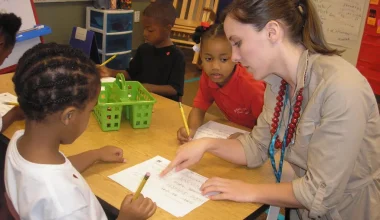Have you ever wondered why private schools have longer holidays? In the United Kingdom, this is a question that often crosses the minds of parents, students, and educators alike.
The discrepancy in holiday durations between private and public schools is indeed a noticeable aspect of the education system. According to recent statistics, private schools typically enjoy an extra week or more of holiday time compared to their public counterparts.
In this article, we will explore the reasons behind this phenomenon, shedding light on the factors that contribute to the extended vacations of private school students.
Let’s get started.

Table of contents
- What is the Length of Private School Holidays in the UK
- Comparing Academic Calendars: Private vs. Public
- Are There Differences in Curriculum and Examinations?
- Cultural Factors Shaping Private School Holidays
- The Connection Between Student Performance and Holidays
- What Role Do School Policies Play?
- FAQs
- Conclusion
- References
- Recommendations
What is the Length of Private School Holidays in the UK
Private school holidays in the United Kingdom typically span anywhere from 11 to 13 weeks throughout the year. These holidays are divided into several breaks, providing students with ample opportunities to relax and recharge.
Now, let’s delve deeper into the specifics of private school holiday durations.
Summer Break
The longest and most eagerly anticipated holiday in the private school calendar is the summer break. Spanning from late July to early September, this holiday usually lasts for approximately six to eight weeks.
During this period, students have the freedom to pursue various activities, including travel, summer camps, or simply enjoying leisure time with family and friends.
Half-Term Breaks
In addition to the summer break, private schools typically have three shorter half-term breaks during the academic year. These breaks usually last for one to two weeks and are strategically placed to provide students with regular opportunities to recharge.
The first half-term break often occurs in late October, followed by another in mid-February, and the final one in late May.
See also: Public vs. Private College: Which is Better?
Winter and Spring Breaks
Private schools also observe winter and spring breaks. The winter break usually spans from mid-December to early January, lasting for about two to three weeks, giving students a chance to celebrate the holiday season and rest before the new year.
The spring break typically falls in early April and lasts for two weeks, providing a refreshing pause as the academic year progresses.
Comparing to Public School Holidays
In contrast, state-funded schools in the UK generally have shorter holidays. They typically follow a similar structure with half-term and holiday breaks but tend to have shorter durations.
The summer break for state schools is often around six weeks, while half-term breaks are typically shorter than those in private schools.
See also: Do In-State Schools Students Have to Follow a National Curriculum?
Comparing Academic Calendars: Private vs. Public
To comprehend the differences in holiday lengths between private and public schools in the UK, it’s essential to compare their academic calendars.
These calendars play a pivotal role in shaping the duration and timing of holidays for students in both types of institutions.
Let’s explore the distinctions between the academic calendars of private and public schools.
Public School Academic Calendar
Public schools in the United Kingdom typically adhere to a standardized academic calendar that aligns with the state educational system. This calendar includes three main terms: autumn, spring, and summer. Each term consists of a specific number of weeks dedicated to teaching and learning.
Between these terms, public schools incorporate breaks and holidays. These breaks are shorter in duration compared to private schools, with term breaks lasting one to two weeks and the summer break typically spanning around six weeks. The academic year is structured to meet government guidelines and regulations, allowing limited flexibility.
Private School Academic Calendar
In contrast, private schools have more autonomy in designing their academic calendars. While they still follow a three-term system, private schools can adjust the length and timing of these terms to suit their specific educational objectives and student needs.
Private schools often take advantage of this flexibility by incorporating longer terms and more extended holiday breaks. For instance, they may extend the summer break to provide students with a more extended period of relaxation and enrichment activities.
These adjustments are made to attract students and accommodate the preferences of parents.
Impact on Holiday Lengths
The differences in academic calendars significantly impact the lengths of holidays in private and public schools.
Private schools use their flexibility to create longer holidays, especially during the summer break, to distinguish themselves from state-funded institutions. These extended breaks are seen as a unique selling point that appeals to parents and students seeking a more leisurely educational experience.
Public schools, constrained by a fixed academic calendar, offer shorter breaks and holidays. While this structure adheres to government regulations, it can sometimes limit the opportunities for students to engage in extended vacations and enrichment activities.
See also: Are Grammar Schools Free? How Much Are Grammar School Fees?
Are There Differences in Curriculum and Examinations?
One of the factors contributing to the variations in holiday durations between private and public schools in the UK lies in the differences in curriculum and examinations.
These disparities influence the timing and frequency of holidays, creating distinctive educational experiences for students.
Curriculum Variations
Private schools often have the freedom to design their own curricula, which can differ significantly from the national curriculum followed by public schools.
This flexibility allows private schools to incorporate unique subjects, teaching methods, and learning outcomes tailored to their educational philosophies and the needs of their students.
Examination Schedules
These differences in curriculum extend to examination schedules, which are a critical consideration in holiday planning.
Private schools may have more control over when and how examinations are conducted. They can set their examination dates and adjust them to align with their academic calendar. This flexibility often results in private schools having the option to schedule exams before or after holiday breaks.
In contrast, public schools, bound by the national curriculum and standardized examination schedules, must adhere to specific examination dates set by government bodies. These dates often fall in the late spring or early summer, restricting the duration of the summer break.
See also: Are Grammar Schools Better? The Pros and Cons of Grammar Schools
Impact on Holiday Durations
The differences in curriculum and examination schedules directly affect holiday durations in both private and public schools.
Private schools may strategically schedule exams before or after holidays, enabling students to enjoy longer breaks without the pressure of exams looming. This approach aligns with their commitment to providing a more leisurely and enriching educational experience.
Public schools, on the other hand, are constrained by the national curriculum and examination timetables. This often results in shorter holiday breaks, particularly during the summer, as students need to prepare for and take their examinations.
Impact on Student Performance
The timing and frequency of examinations also have implications for student performance.
Private school students may benefit from the extended breaks between exams, as they have more time for revision and preparation. This can contribute to improved academic outcomes.
In public schools, the shorter holiday periods leading up to exams can create a more intensive study period, potentially affecting stress levels and performance.
See also: What are Free Schools and Its Purpose in the UK?
Cultural Factors Shaping Private School Holidays
When examining the differences in holiday lengths between private and public schools in the UK, it’s essential to consider the cultural factors that influence holiday planning and scheduling.
Cultural values, traditions, and expectations play a substantial role in shaping the holiday experience for students in private schools.
Celebration of Religious Holidays
One notable cultural factor is the celebration of religious holidays. Private schools, often associated with specific religious denominations, may align their holiday schedules with important religious observances.
For example, Christian private schools might have extended breaks during Christmas and Easter, reflecting the significance of these holidays in Christian culture.
Cultural traditions also influence private school holidays.
Private schools may incorporate cultural festivals and traditions into their holiday schedules. This can include celebrating Diwali, Eid, or other cultural events, which can result in additional time off to observe these traditions.
Impact on Holiday Durations
These cultural factors can lead to longer holidays in private schools compared to public schools.
Private schools that prioritize cultural observances may provide extended breaks to allow students and staff to fully participate in these celebrations. These breaks can add to the overall length of holidays in private institutions.
In contrast, public schools, which serve a diverse student population, may have a more standardized approach to holidays, accommodating a wide range of cultural backgrounds but with less emphasis on specific cultural observances.
Moreover, parental expectations and cultural significance also contribute to holiday planning in private schools.
Private schools often cater to parents who have specific expectations regarding holidays. These expectations may be influenced by cultural norms and the desire to have quality family time during holidays.
Private schools that emphasize cultural identity may extend holidays to allow students to connect with their cultural heritage. This aligns with the school’s mission to provide a holistic educational experience.
See also: How Do You Get A Scholarship For Private Schools?
The Connection Between Student Performance and Holidays
The link between student performance and holidays is a crucial aspect to consider when exploring the reasons behind the varying holiday lengths in private and public schools. These breaks have a direct impact on how students perform academically.
For private schools, longer holidays can potentially lead to improved academic outcomes. Students have more time for revision, relaxation, and pursuing personal interests. This additional time can reduce stress and help students achieve better results.
In public schools, the shorter holiday periods, especially leading up to standardized exams, may create a more intense study atmosphere. While this can be challenging, it may motivate students to focus on their studies and excel in their exams.
However, the connection between student performance and holidays is not solely about exam results. Extended breaks also offer students opportunities for personal growth, development, and engagement in extracurricular activities. These experiences can enrich their overall education and shape them into well-rounded individuals.
See also: Are Schools Public Sector Organisations?
What Role Do School Policies Play?
School policies are instrumental in shaping the holiday durations and overall educational experience in both private and public schools. These policies serve as a set of guidelines that schools adhere to, influencing various aspects of holiday planning and management.
In private schools, where autonomy is more pronounced, school policies play a significant role in determining the length and timing of holidays. These policies are often tailored to meet the specific needs and goals of the institution. For instance, a private school with a strong focus on extracurricular activities may have policies that allow for extended breaks to accommodate these activities.
On the other hand, public schools, which are typically subject to government regulations, must adhere to standardized policies. These policies ensure uniformity across the education system, including holiday schedules. The government sets guidelines for term dates and holidays, limiting the flexibility of individual public schools in planning their academic calendars.
School policies also influence attendance requirements, which can impact holiday lengths. Private schools may have more lenient policies regarding attendance during holiday periods, whereas public schools are often stricter in this regard, ensuring that students attend school consistently throughout the academic year.
See also: How Long Does it Take to Transfer Schools in the UK: A Guide for Parents
FAQs
Generally speaking, school half terms in the UK are usually in February, May, and October (part way through the term). Half-term holidays in the UK are normally 1-week long, and end-of-term holidays are usually longer. Summer holidays typically start towards the end of July and run for up to 6 weeks.
Children attending state schools in England and Wales typically take a six-week summer holiday before starting school again at the beginning of September. Scotland has an early summer break, so students return around the middle of August.
Private school students typically attend school for around 190 days per year.
Conclusion
The question of “Why do private schools have longer holidays in the UK?” is a multifaceted one, influenced by various factors, including funding, academic calendars, teacher contracts, and parental expectations, among others.
These differences contribute to the unique holiday schedules observed in private schools. Understanding these factors can provide valuable insights into the dynamics of the UK education system.
As we’ve explored in this article, it’s not a simple matter of longer holidays but rather a complex interplay of educational, financial, and cultural elements that shape private school holiday durations.
References
- Forum.digitalspy.com – Do all schools in the UK get the same amount of school holidays?
- Schoolfeesplanning.org – EVERYTHING YOU NEED TO KNOW ABOUT PRIVATE SCHOOL EDUCATION
- Thinkstudent.uk.co – When Do Private Schools Start in 2023?




